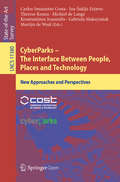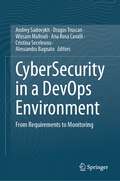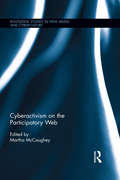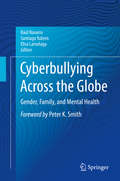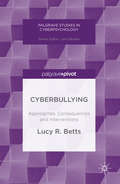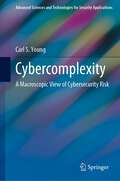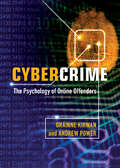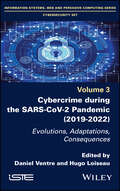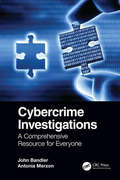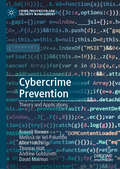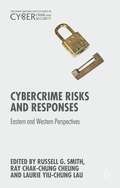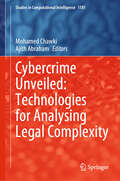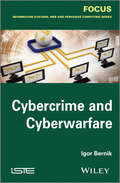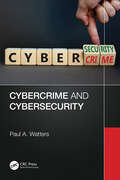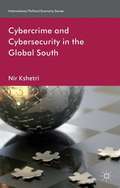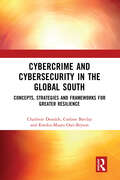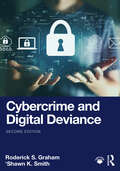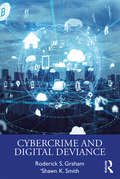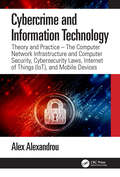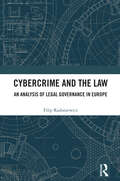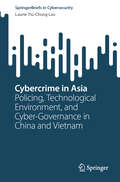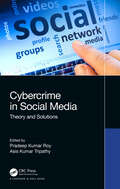- Table View
- List View
CyberParks – The Interface Between People, Places and Technology: New Approaches and Perspectives (Lecture Notes in Computer Science #11380)
by Michiel De Lange Martijn De Waal Carlos Smaniotto Costa Ina Šuklje Erjavec Therese Kenna Konstantinos Ioannidis Gabriela MaksymiukThis open access book is about public open spaces, about people, and about the relationship between them and the role of technology in this relationship. It is about different approaches, methods, empirical studies, and concerns about a phenomenon that is increasingly being in the centre of sciences and strategies – the penetration of digital technologies in the urban space. As the main outcome of the CyberParks Project, this book aims at fostering the understanding about the current and future interactions of the nexus people, public spaces and technology. It addresses a wide range of challenges and multidisciplinary perspectives on emerging phenomena related to the penetration of technology in people’s lifestyles - affecting therefore the whole society, and with this, the production and use of public spaces. Cyberparks coined the term cyberpark to describe the mediated public space, that emerging type of urban spaces where nature and cybertechnologies blend together to generate hybrid experiences and enhance quality of life.
CyberSecurity in a DevOps Environment: From Requirements to Monitoring
by Cristina Seceleanu Ana Rosa Cavalli Andrey Sadovykh Dragos Truscan Wissam Mallouli Alessandra BagnatoThis book provides an overview of software security analysis in a DevOps cycle including requirements formalisation, verification and continuous monitoring. It presents an overview of the latest techniques and tools that help engineers and developers verify the security requirements of large-scale industrial systems and explains novel methods that enable a faster feedback loop for verifying security-related activities, which rely on techniques such as automated testing, model checking, static analysis, runtime monitoring, and formal methods. The book consists of three parts, each covering a different aspect of security engineering in the DevOps context. The first part, "Security Requirements", explains how to specify and analyse security issues in a formal way. The second part, "Prevention at Development Time", offers a practical and industrial perspective on how to design, develop and verify secure applications. The third part, "Protection at Operations", eventually introduces tools for continuous monitoring of security events and incidents. Overall, it covers several advanced topics related to security verification, such as optimizing security verification activities, automatically creating verifiable specifications from security requirements and vulnerabilities, and using these security specifications to verify security properties against design specifications and generate artifacts such as tests or monitors that can be used later in the DevOps process. The book aims at computer engineers in general and does not require specific knowledge. In particular, it is intended for software architects, developers, testers, security professionals, and tool providers, who want to define, build, test, and verify secure applications, Web services, and industrial systems.
Cyberactivism on the Participatory Web (Routledge Studies in New Media and Cyberculture)
by Martha McCaugheyCyberactivism already has a rich history, but over the past decade the participatory web—with its de-centralized information/media sharing, portability, storage capacity, and user-generated content—has reshaped political and social change. Cyberactivism on the Participatory Web examines the impact of these new technologies on political organizing and protest across the political spectrum, from the Arab Spring to artists to far-right groups. Linking new information and communication technologies to possibilities for solidarity and action—as well as surveillance and control—in a context of global capital flow, war, and environmental crisis, the contributors to this volume provide nuanced analyses of the dramatic transformations in media, citizenship, and social movements taking place today.
Cyberbullying
by Juan Moises de la Serna Beatriz Sosa RebeloO cyberbullying é uma nova modalidade de assédio que qualquer pessoa pode vir a sofrer, mas a situação é especialmente preocupante quando se trata de menores. Neste breve manual são respondidas as perguntas mais importantes sobre este tema que todo pai com filhos em idade escolar deve ter em mente: O que é o Cyberbullying? Quais os efeitos do Cyberbullying? Pode se prevenir o Cyberbullying? e principalmente, O que fazer se nosso filho for vítima do Cyberbullying? Descubra todos os segredos sobre o Cyberbullying com os resultados das últimas pesquisas realizadas no âmbito da psicologia sobre o assunto.
Cyberbullying
by Juan Moises de la Serna Conchi FuentesCyberbullying is a modern form of harassment that anyone can suffer, but the situation is especially worrying when dealing with minors.This short guide presents answers to some of the most important questions on this subject that any parent with children of school age should bear in mind, such as: What is cyberbullying? How does cyberbullying affect people? Can cyberbullying be prevented? And, above all, what to do if your child is suffering from cyberbullying? Discover all the facts about cyberbullying, based on results from the latest research in the field of psychology on this matter.
Cyberbullying
by Vanessa RogersChildren and teenagers text, network and twitter online as second nature, but when emails or texts are used to threaten, harass, intimidate or embarrass someone, they can turn from being a source of enjoyment to a source of crippling anxiety and fear. This approachable book is packed with advice, games and activities for groups and individuals to help young people understand what cyberbullying is, how they should behave online and how they can stay safe. The activities range from quizzes and competitions to storyboard games and art activities, and cover issues such as how easily personal information can be forwarded, the risks posed by unknown 'friends' on social networking sites, and how to discuss and deal with bullying issues. They are designed to encourage young people to think about their own behaviour and attitudes and give them the skills and knowledge to stay safe in a digital world. Particularly suited to children and teens aged 11+, this essential book will be an invaluable resource for parents, teachers, youth workers, and anyone working with young people who could be exposed to cyberbullying.
Cyberbullying Across the Globe: Gender, Family, and Mental Health
by Raúl Navarro Santiago Yubero Elisa LarrañagaThis book provides a much-needed analysis of the current research in the global epidemic of electronic bullying. Scholars and professionals from the Americas, Europe, and Asia offer data, insights, and solutions, acknowledging both the social psychology and technological contexts underlying cyberbullying phenomena. Contributors address questions that are just beginning to emerge as well as longstanding issues concerning family and gender dynamics, and provide evidence-based prevention and intervention strategies for school and home. The global nature of the book reflects not only the scope and severity of cyberbullying, but also the tenacity of efforts to control and eradicate the problem. Included in the coverage: * Gender issues and cyberbullying in children and adolescents: from gender differences to gender identity measures. * Family relationships and cyberbullying. * Examining the incremental impact of cyberbullying on outcomes over and above traditional bullying in North America. * A review of cyberbullying and education issues in Latin America. * Cyberbullying prevention from child and youth literature. * Cyberbullying and restorative justice. Cyberbullying across the Globe is an essential resource for researchers, graduate students, and other professionals in child and school psychology, public health, social work and counseling, educational policy, and family advocacy.
Cyberbullying: Approaches, Consequences and Interventions (Palgrave Studies in Cyberpsychology)
by Lucy R. BettsDrawing on research evidence and media coverage, this book explores a number of key debates surrounding cyberbullying. The increasing digitization of society affords many benefits; however, some of these benefits are offset by more adverse consequences. Cyberbullying represents one of the adverse consequences of technology use, which has become a topic of increasing societal concern. Betts adopts a critical stance to exploring issues around the definition of cyberbullying, the unique nature of cyberbullying compared to other forms of bullying, the variation in the reported prevalence rates of cyberbullying, the consequences of involvement in cyberbullying, and the steps that can be taken to tackle cyberbullying.
Cybercomplexity: A Macroscopic View of Cybersecurity Risk (Advanced Sciences and Technologies for Security Applications)
by Carl S. YoungThis book tackles the problem of complexity within IT environments, i.e., "Cybercomplexity," which is generally recognized as a principal source of cybersecurity risk. The book first defines complexity and simplifies its analysis by assuming a probabilistic approach to security risk management. It then proposes a simple model of cybercomplexity that is based on Shannon entropy, a basic concept in information theory. The key drivers of cybercomplexity emerge from this model, where these drivers reveal the scale-dependence of cybersecurity risk and explain why macroscopic security controls are required to address cybersecurity risk on an enterprise scale. The significant operational implications of cybercomplexity are also discussed, thereby providing both a theoretical framework and a practical guide to addressing this longstanding problem in cybersecurity risk management.
Cybercrime
by Andrew Power Gráinne KirwanCybercrime is a growing problem in the modern world. Despite the many advantages of computers, they have spawned a number of crimes, such as hacking and virus writing, and made other crimes more prevalent and easier to commit, including music piracy, identity theft and child sex offences. Understanding the psychology behind these crimes helps to determine what motivates and characterises offenders and how such crimes can be prevented. This textbook on the psychology of the cybercriminal is the first written for undergraduate and postgraduate students of psychology, criminology, law, forensic science and computer science. It requires no specific background knowledge and covers legal issues, offenders, effects on victims, punishment and preventative measures for a wide range of cybercrimes. Introductory chapters on forensic psychology and the legal issues of cybercrime ease students into the subject, and many pedagogical features in the book and online provide support for the student.
Cybercrime During the SARS-CoV-2 Pandemic: Evolutions, Adaptations, Consequences
by Daniel Ventre Hugo LoiseauThe SARS-CoV-2 pandemic has had an undeniable impact on cybercrime. The initial crisis quickly became a global catastrophe with multiple consequences in economics, health, and political and social fields. This book explores how this global emergency has influenced cybercrime. Indeed, since feeding off new vulnerabilities, thanks to the effects of the pandemic crisis in various states around the world, cybercrime has increased and evolved.In 2020, the world was already dealing with numerous tensions and the effects of the global crisis have therefore only tended to exacerbate the issues that relate to cybercrime. For example, radicalization and identity theft has found an environment in which they thrive: the Internet. Criminals have been able to adapt their modus operandi, their targets and their attack vectors. However, on the plus side, the response of law enforcement and public authorities, in terms of the legal, policing and policy side of cybercrime, has also been adapted in order to better combat the increase in this phenomenon.
Cybercrime Investigations: A Comprehensive Resource for Everyone
by John BandlerCybercrime continues to skyrocket but we are not combatting it effectively yet. We need more cybercrime investigators from all backgrounds and working in every sector to conduct effective investigations. This book is a comprehensive resource for everyone who encounters and investigates cybercrime, no matter their title, including those working on behalf of law enforcement, private organizations, regulatory agencies, or individual victims. It provides helpful background material about cybercrime's technological and legal underpinnings, plus in-depth detail about the legal and practical aspects of conducting cybercrime investigations. Key features of this book include: Understanding cybercrime, computers, forensics, and cybersecurity Law for the cybercrime investigator, including cybercrime offenses; cyber evidence-gathering; criminal, private and regulatory law, and nation-state implications Cybercrime investigation from three key perspectives: law enforcement, private sector, and regulatory Financial investigation Identification (attribution) of cyber-conduct Apprehension Litigation in the criminal and civil arenas. This far-reaching book is an essential reference for prosecutors and law enforcement officers, agents and analysts; as well as for private sector lawyers, consultants, information security professionals, digital forensic examiners, and more. It also functions as an excellent course book for educators and trainers. We need more investigators who know how to fight cybercrime, and this book was written to achieve that goal. Authored by two former cybercrime prosecutors with a diverse array of expertise in criminal justice and the private sector, this book is informative, practical, and readable, with innovative methods and fascinating anecdotes throughout.
Cybercrime Prevention: Theory and Applications (Crime Prevention and Security Management)
by Andrew Goldsmith Russell Brewer Melissa de Vel-Palumbo Alice Hutchings Thomas Holt David MaimonThis book articulates how crime prevention research and practice can be reimagined for an increasingly digital world. This ground-breaking work explores how criminology can apply longstanding, traditional crime prevention techniques to the digital realm. It provides an overview of the key principles, concepts and research literature associated with crime prevention, and discusses the interventions most commonly applied to crime problems. The authors review the theoretical underpinnings of these and analyses evidence for their efficacy. Cybercrime Prevention is split into three sections which examine primary prevention, secondary prevention and tertiary prevention. It provides a thorough discussion of what works and what does not, and offers a formulaic account of how traditional crime prevention interventions can be reimagined to apply to the digital realm.
Cybercrime Risks and Responses: Eastern And Western Perspectives (Palgrave Macmillan's Studies In Cybercrime And Cybersecurity Ser.)
by Russell Smith Ray Chak-Chung Cheung Laurie Yiu-Chung LauThis book series addresses the urgent need to advance knowledge in the fields of cybercrime and cybersecurity. Because the exponential expansion of computer technologies and use of the Internet have greatly increased the access by criminals to people, institutions, and businesses around the globe, the series will be international in scope. It provides a home for cutting-edge long-form research. Further, the series seeks to spur conversation about how traditional criminological theories apply to the online environment. The series welcomes contributions from early career researchers as well as established scholars on a range of topics in the cybercrime and cybersecurity fields.
Cybercrime Unveiled: Technologies for Analysing Legal Complexity (Studies in Computational Intelligence #1181)
by Ajith Abraham Mohamed ChawkiThe book offers a comprehensive examination of the ever-evolving landscape of cybercrime. Bringing together experts from various legal and technical backgrounds, this book presents an integrated approach to understanding the complexities of cyber threats. It explores various topics, from social engineering and AI-enhanced cybercrime to international cybersecurity governance and the Dark Web’s role in money laundering. By offering theoretical insights and practical case studies, the book is a vital resource for policymakers, cybersecurity professionals, legal experts, and academics seeking to grasp the intricacies of cybercrime. This book includes 15 rigorously selected chapters from 31 submissions, chosen through a double-blind peer review by an international panel of referees. Each chapter delves into a unique aspect of cybercrime, from the role of AI in modern cyber threats to the emerging legal challenges posed by global cybersecurity norms. Contributors from around the world provide diverse perspectives, making this book a global reference on the topic of cybercrime and digital security. As cybercrime continues to grow in both complexity and impact, this book highlights the critical importance of collaboration between legal and technical experts. By addressing the key challenges posed by cyber threats, whether through AI, cryptocurrency, or state sovereignty—this book provides readers with actionable insights and strategies to tackle the most pressing issues in the digital age.
Cybercrime and Cyber Warfare
by Igor BernikIn order to enable general understanding and to foster the implementation of necessary support measures in organizations, this book describes the fundamental and conceptual aspects of cyberspace abuse. These aspects are logically and reasonably discussed in the fields related to cybercrime and cyberwarfare. The book illustrates differences between the two fields, perpetrators’ activities, as well as the methods of investigating and fighting against attacks committed by perpetrators operating in cyberspace. The first chapter focuses on the understanding of cybercrime, i.e. the perpetrators, their motives and their organizations. Tools for implementing attacks are also briefly mentioned, however this book is not technical and does not intend to instruct readers about the technical aspects of cybercrime, but rather focuses on managerial views of cybercrime. Other sections of this chapter deal with the protection against attacks, fear, investigation and the cost of cybercrime. Relevant legislation and legal bodies, which are used in cybercrime, are briefly described at the end of the chapter. The second chapter deals with cyberwarfare and explains the difference between classic cybercrime and operations taking place in the modern inter-connected world. It tackles the following questions: who is committing cyberwarfare; who are the victims and who are the perpetrators? Countries which have an important role in cyberwarfare around the world, and the significant efforts being made to combat cyberwarfare on national and international levels, are mentioned. The common points of cybercrime and cyberwarfare, the methods used to protect against them and the vision of the future of cybercrime and cyberwarfare are briefly described at the end of the book. Contents 1. Cybercrime. 2. Cyberwarfare. About the Authors Igor Bernik is Vice Dean for Academic Affairs and Head of the Information Security Lab at the University of Maribor, Slovenia. He has written and contributed towards over 150 scientific articles and conference papers, and co-authored 4 books. His current research interests concern information/cybersecurity, cybercrime, cyberwarfare and cyberterrorism.
Cybercrime and Cybersecurity
by Paul A. WattersThe field of cybersecurity and cybercrime is a critical and rapidly evolving area of study. As our society becomes more and more reliant on technology, the risks of cybercrime increase. This book provides a comprehensive introduction to the field, covering both cybercrime and cybersecurity. The book starts by providing an overview of common threats and the risk management view of cybercrime. It explores the different types of threats, such as hacking, malware, phishing, and social engineering, and the various ways in which they can impact individuals, businesses, and society at large. It also introduces the concept of risk management and the different approaches that can be used to manage cyber risks, such as risk avoidance, mitigation, transfer, and acceptance. From there, the book delves into the three key areas of cybersecurity: people, process, and technology. It explores the role of people in cybersecurity, including staffing, psychological profiling, role sensitivity, awareness, training, and education. It also examines the importance of process, including strategy and governance, policy, configuration management, and physical security. Finally, the book explores the critical role of technology, including system security, identification and authentication, authorisation and access control, and cryptography. The book is designed to be accessible to a wide range of readers, from first-year students studying cybercrime and cybersecurity for the first time to seasoned professionals who need to better understand the purpose of cybersecurity programmes and controls. It is written in a clear and concise manner, with each chapter building on the previous one to provide a comprehensive overview of the field. Overall, this book is an essential resource for anyone interested in the field of cybersecurity and cybercrime. It provides a critical introduction to the key concepts, theories, and practices in the field, and is sure to be a valuable reference for years to come.
Cybercrime and Cybersecurity in the Global South
by Nir KshetriIntegrating theories from a wide range of disciplines, Nir Kshetri compares the patterns, characteristics and processes of cybercrime activities in major regions and economies in the Global South such as China, India, the former Second World economies, Latin America and the Caribbean, Sub-Saharan Africa and Middle East and North Africa.
Cybercrime and Cybersecurity in the Global South: Concepts, Strategies and Frameworks for Greater Resilience
by Corlane Barclay Kweku-Muata Osei-Bryson Charlette DonaldsThe Global South is recognized as one of the fastest growing regions in terms of Internet population as well as the region that accounts for the majority of Internet users. However, It cannot be overlooked that with increasing connectivity to and dependence on Internet-based platforms and services, so too is the potential increased for information and cybersecurity threats and attacks. Further, it has long been established that micro, small, and medium enterprises (MSMEs) play a key role in national economies, serving as important drivers of economic growth in Global South economies. Yet, little is known about information security, cybersecurity and cybercrime issues and strategies contextualized to these developing economies and MSMEs. Cybercrime and Cybersecurity in the Global South: Concepts, Strategies and Frameworks for Greater Resilience examines the prevalence, nature, trends and impacts of cyber-related incidents on Global South economies. It further explores cybersecurity challenges, potential threats, and risks likely faced by MSMEs and governments of the Global South. A major thrust of this book is to offer tools, techniques, and legislative frameworks that can improve the information, data, and cybersecurity posture of Global South governments and MSMEs. It also provides evidence-based best practices and strategies relevant to the business community and general Information Communication Technology (ICT) users in combating and preventing cyber-related incidents. Also examined in this book are case studies and experiences of the Global South economies that can be used to enhance students’ learning experience. Another important feature of this book is that it outlines a research agenda to advance the scholarship of information and cybersecurity in the Global South. Features: Cybercrime in the Caribbean Privacy and security management Cybersecurity compliance behaviour Developing solutions for managing cybersecurity risks Designing an effective cybersecurity programme in the organization for improved resilience The cybersecurity capability maturity model for sustainable security advantage Cyber hygiene practices for MSMEs A cybercrime classification ontology
Cybercrime and Digital Deviance
by Roderick S. Graham 'Shawn K. SmithCybercrime and Digital Deviance, Second Edition, combines insights from sociology, criminology, psychology, and cybersecurity to explore cybercrimes such as hacking, identity theft, and romance scams, along with forms of digital deviance such as pornography addiction, trolling, and “canceling” people for perceived violations of norms.Other issues are explored including cybercrime investigations, nation-state cybercrime, the use of algorithms in policing, cybervictimization, and expanded discussion of the theories used to explain cybercrime. Graham and Smith conceptualize the online space as a distinct environment for social interaction, framing their work with assumptions informed by their respective work in urban sociology and spatial criminology, and offering an engaging entry point for understanding what may appear to be a technologically complex course of study. The authors apply a modified version of a typology developed by David Wall: cybertrespass, cyberfraud, cyberviolence, and cyberpornography. This typology is simple enough for students just beginning their inquiry into cybercrime, while its use of legal categories of trespassing, fraud, violent crimes against persons, and moral transgressions provides a solid foundation for deeper study. In this edition each chapter includes a new “Current Events and Critical Thinking” section, using concepts from the chapter to explore a specific event or topic like the effect of disinformation on social cohesion and politics.Taken together, Graham and Smith’s application of a digital environment and Wall’s cybercrime typology makes this an ideal upper-level text for students in sociology and criminal justice. It is also an ideal introductory text for students within the emerging disciplines of cybercrime and cybersecurity.
Cybercrime and Digital Deviance
by Roderick Graham 'Shawn SmithCybercrime and Digital Deviance is a work that combines insights from sociology, criminology, and computer science to explore cybercrimes such as hacking and romance scams, along with forms of cyberdeviance such as pornography addiction, trolling, and flaming. Other issues are explored including cybercrime investigations, organized cybercrime, the use of algorithms in policing, cybervictimization, and the theories used to explain cybercrime. Graham and Smith make a conceptual distinction between a terrestrial, physical environment and a single digital environment produced through networked computers. Conceptualizing the online space as a distinct environment for social interaction links this text with assumptions made in the fields of urban sociology or rural criminology. Students in sociology and criminology will have a familiar entry point for understanding what may appear to be a technologically complex course of study. The authors organize all forms of cybercrime and cyberdeviance by applying a typology developed by David Wall: cybertrespass, cyberdeception, cyberviolence, and cyberpornography. This typology is simple enough for students just beginning their inquiry into cybercrime. Because it is based on legal categories of trespassing, fraud, violent crimes against persons, and moral transgressions it provides a solid foundation for deeper study. Taken together, Graham and Smith’s application of a digital environment and Wall’s cybercrime typology makes this an ideal upper level text for students in sociology and criminal justice. It is also an ideal introductory text for students within the emerging disciplines of cybercrime and cybersecurity.
Cybercrime and Information Technology: The Computer Network Infrastructure and Computer Security, Cybersecurity Laws, Internet of Things (IoT), and Mobile Devices
by Alex AlexandrouCybercrime and Information Technology: Theory and Practice—The Computer Network Infostructure and Computer Security, Cybersecurity Laws, Internet of Things (IoT), and Mobile Devices is an introductory text addressing current technology, trends, and security issues. While many books on the market cover investigations, forensic recovery, and presentation of evidence, and others explain computer and network security, this book explores both, explaining the essential principles governing computers, wireless and mobile devices, the Internet of Things, cloud systems, and their significant vulnerabilities. Only with this knowledge can students truly appreciate the security challenges and opportunities for cybercrime that cannot be uncovered, investigated, and adjudicated unless they are understood. The legal portion of the book is an overview of the legal system in the United States, including cyberlaw standards, and regulations affecting cybercrime. This section includes cases in progress that are shaping and developing legal precedents. As is often the case, new technologies require new statues and regulations—something the law is often slow to move on given the current speed in which technology advances. Key Features: Provides a strong foundation of cybercrime knowledge along with the core concepts of networking, computer security, Internet of Things (IoTs), and mobile devices. Addresses legal statutes and precedents fundamental to understanding investigative and forensic issues relative to evidence collection and preservation. Identifies the new security challenges of emerging technologies including mobile devices, cloud computing, Software-as-a-Service (SaaS), VMware, and the Internet of Things. Strengthens student understanding of the fundamentals of computer and network security, concepts that are often glossed over in many textbooks, and includes the study of cybercrime as critical forward-looking cybersecurity challenges. Cybercrime and Information Technology is a welcome addition to the literature, particularly for those professors seeking a more hands-on, forward-looking approach to technology and trends. Coverage is applicable to all forensic science courses in computer science and forensic programs, particularly those housed in criminal justice departments emphasizing digital evidence and investigation processes. The textbook is appropriate for courses in the Computer Forensics and Criminal Justice curriculum, and is relevant to those studying Security Administration, Public Administrations, Police Studies, Business Administration, Computer Science, and Information Systems. An Instructor’s Manual with Test Bank and chapter PowerPoint slides is available to qualified professors for use in classroom instruction.
Cybercrime and the Law: An Analysis of Legal Governance in Europe
by Filip RadoniewiczThis book provides a comprehensive and synthetic analysis of the legal acts of the Council of Europe and the European Union affecting regulation of cybercrime in EU countries. Technical aspects relating to cybercrime are also discussed. The work explains core ideas, including background, nomenclature, a definition of computer crime and a history of its criminalisation. It examines the Council of Europe’s Convention on Cybercrime, the first international law act governing the subject, and the additional Protocol to the Convention on Cybercrime, dealing with the criminalisation of computer-generated racist and xenophobic acts. The volume discusses European Union regulations, including applicable European Union laws on cybercrime such as the Council Framework Decision 2005/222/JHA and Directive 2013/40/EU on attacks against information systems, and Directive 2011/93/EU on Combating the Sexual Abuse and Sexual Exploitation of Children and Child Pornography. Finally, the work explores issues of cyberterrorism including the dissemination of terrorist content online. The book will be a valuable resource for academics, researchers and policy-makers working in the areas of criminal law, IT law, EU law and cyber security.
Cybercrime in Asia: Policing, Technological Environment, and Cyber-Governance in China and Vietnam (SpringerBriefs in Cybersecurity)
by Laurie Yiu-Chung LauThis work examines the most pressing and contentious issues in cybercrime currently facing the China and Vietnam, and how best to tackle them. The text sets the context for how blocs of nations (including the least ready, the most ready, and those occupying a central position in terms of cybercrime readiness) react to the evolving challenges of cybercrime, with a focus on prevention and control. In this way, the work discusses why certain blocs of nations in the Asia-Pacific region are not at an optimal level of cybercrime readiness despite the rapid pace of technological advancement in this region, and how such nations can become regional leaders in cybercrime readiness.
Cybercrime in Social Media: Theory and Solutions
by Asis Kumar Tripathy Pradeep Kumar RoyThis reference text presents the important components for grasping the potential of social computing with an emphasis on concerns, challenges, and benefits of the social platform in depth. Features: Detailed discussion on social-cyber issues, including hate speech, cyberbullying, and others Discusses usefulness of social platforms for societal needs Includes framework to address the social issues with their implementations Covers fake news and rumor detection models Describes sentimental analysis of social posts with advanced learning techniques The book is ideal for undergraduate, postgraduate, and research students who want to learn about the issues, challenges, and solutions of social platforms in depth.
